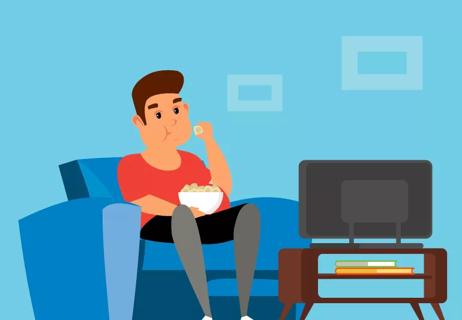Gamers should approach esports with an athlete’s mindset

Limbering up and stretching is key for any athlete looking to minimize the risk of injury and boost performance. That’s a well-established belief in traditional sports, and it’s equally true in esports for competitive video game athletes.
Advertisement
Cleveland Clinic is a non-profit academic medical center. Advertising on our site helps support our mission. We do not endorse non-Cleveland Clinic products or services. Policy
Esports athletes need to prepare their bodies — particularly their fingers, hands and wrists — to compete at the highest levels. Attention to physical training is critical to gamer health and success in the e-field of play.
The average professional esports athlete devotes 5½ to 10 hours per day honing their skills. The typical at-home gamer spends about an hour a day on a controller.
For both sets of players, that brings wear and tear to specific joints that should not be ignored, says sports medicine physician Dominic King, DO, and chiropractic physician Drew Schwartz, DC.
“Esports athletes face a very specific set of physical stresses,” notes Dr. King, director of the Cleveland Clinic Esports Medicine program. “If you’re going to play, you need to be prepared for the demands.”
Overuse injuries to fingers, hands, wrists and elbows reflect the physical toll of esports. A top gamer performs 500 to 600 moves per minute on a controller. That works out to about 10 moves per second.
“It turns into a load management issue,” says Dr. Schwartz. “Your body just can’t handle what you’re asking it to do.”
That can result in:
Advertisement
“When you combine competition, volume and intensity, any athlete is at risk for injury,” says Dr. King.
For starters, take a break — something that’s easier said than done given the appreciation gamers have for the grind. “Long hours are looked at like a badge of honor and they shouldn’t be,” acknowledges Dr. Schwartz. “It’s typically inefficient time management and training.”
Ideally, though, gamers should put down their controller after about 30 to 45 minutes of competition to give their body a break. Dr. Schwartz recommends getting up and moving around for a few minutes.
If hand or wrist pain develops at any time while playing, it’s best to stop before symptoms worsen. “Don’t try to just continue through it,” says Dr. Schwartz. “Be mindful of the pain and address it.”
Stretching your fingers, hands and wrists also is important to prepare for the rigors of gaming.
“If you’re a basketball player or a sprinter, you’d never think of competing without warming up first,” notes Dr. Schwartz. “It’s part of the preparation process. Why would gaming be any different?”
Here are four stretches gamers should try before logging in.
Open your right hand and extend it back from your wrist, spreading your fingers wide in the process. Now flex your wrist forward while bringing your fingers together in tight formation, as if they’re forming a point.
Repeat the stretch multiple times over 30 seconds in a slow-and-controlled cadence. Then switch to the left hand and restart.
Open your right hand and straighten your fingers. Use your left hand to gently pull back on your four extended fingers — basically, all fingers other than your thumb. Go to the end range of what your tissue will allow. Don’t force your fingers back. Hold the stretch for 10 seconds.
Repeat the move three times on each hand.
Extend your left hand and hold it rigid. Extend your index finger on your right hand and press it against your left hand, stretching it back. Hold for five seconds. Repeat with your middle finger, ring finger and pinkie.
Switch hands and repeat the process with the fingers on your left land pressing against your right hand.
You can also do this stretch against a hard surface such as a table. Once again, the tissue in your hand will let you know the end range of the stretch. There is no need to force your fingers back.
Bend your fingers (other than the thumb) at the knuckles on your right hand. Your fingertips should touch the pads at the base of your fingers. Use your left hand to gently push back on the curled fingers, flexing them toward the back of your hand. Hold for 10 seconds.
Advertisement
Repeat the move three times. Switch hands and restart.
If you overdo it on the controller, Dr. Schwartz recommends a combination of ice and heat treatment to soothe inflammation.
Use ice on tendons, such as the tough, rope-like cords running up each finger. (Wiggle your fingers and you’ll see the tendons stretching and moving on the top of your hand.) Rub the ice along the tendon for a gentle massage while moving the joint through a light range of motion.
Heat works better to calm pain in meatier areas, such as your palm or forearm.
So why the focus on preventing esports injuries? The answer to that is simple: It’s needed.
To describe esports as “booming” seems like an understatement. The global population of esports enthusiasts is expected to approach 300 million by 2024. In 2019, by comparison, the number was less than 200 million.
Professional sports leagues such as the NBA are launching esports ventures, and numerous colleges now field esports teams and offer scholarships to gamers.
Add in casual gamers and the number of people working controllers swells into the billions.
“Just look at the numbers,” says Dr. King. “There are millions of dedicated competitive gamers out there and the competition is growing. With increased competition comes an increase in injuries. Competitive video game athletes deserve the same approach to health, wellness and performance that we offer to all other traditional sports athletes.”
Advertisement
Learn more about our editorial process.
Advertisement

Too much blue light, especially from digital sources, may lead to eye strain and computer vision syndrome

When done in excess, watching TV can disrupt your sleep and lead to physical inactivity and social isolation

Imagination, completing tasks and social interactions are all key benefits for your brain

It can affect your child’s development, but not in a way you might think

An expert shares when it’s time to limit your kids’ tablet or TV time

How taking in too many gruesome stories can impact your well-being

How to avoid excessive online + gaming — from toddlers to teens

Five tips for breaking your distracted eating habit

If your nose is constantly running, it could be allergies, chronic sinusitis, nasal polyps or other concerns

If you find yourself obsessing over rejection or a one-sided relationship, you’re likely stuck in limerence

Alcohol is a depressant and can interfere with your sleep, mood and more